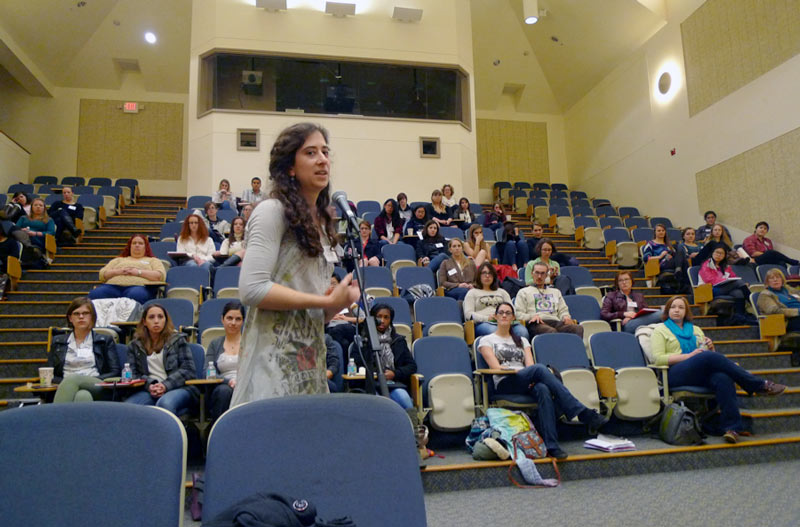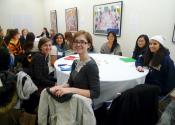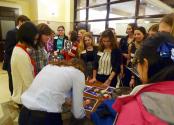Conferences for Undergraduate Women in Physics
January 16, 2015 to January 18, 2015
Durham, North Carolina
Meeting host: By:Jenny Su
SPS Chapter:

In order to encourage more women to be in physics, we just need to have more women in physics. This is the seemingly paradoxical solution to the low ratio of women to men in physics departments. The best way to encourage more female students to continue in physics who would be to have more female physicists to serve as role models and fellow peers in the path of academia. However, in order to have more role models and peers, there need to be more women in physics to begin with.
To address this issue, the American Physical Society (APS) Conferences for Undergraduate Women in Physics (CUWiP) serve to “help undergraduate women continue in physics by providing them with the opportunity to experience a professional conference, information about graduate school and professions in physics, and access to other women in physics of all ages with whom they can share experiences, advice, and ideas.” 1 The CUWiPs have multiple regional sites that all meet the same weekend. The one I attended, the North Carolina Research Triangle location, brought together female physicists from all over the Southeast region. Attendees included students and professionals on faculty, research, industrial, and non-physics related paths.
The conference began on Friday January 16, on Duke University’s East Campus. Students travelled from Georgia, Florida, Virginia, Tennessee, South Carolina, and North Carolina to participate in the discussions, panels, research talks, and poster sessions. The first half-day was full of excitement as students met fellow physics students from all over the South. They interacted through a game of “Physicist Bingo” put together by the local organizing committee to get to know students from other schools.
A panel on Friday evening brought together female physicists who had careers in industries outside of academia. It was incredibly interesting to get a sense of the vast number opportunities that are available for physics students. With careers in areas ranging from patent law and public health to defense think tanks and Silicon Valley startups, the panel members were great examples of the different paths physicists can take. Even though some may work in fields that seem far from their physics roots, it was evident that their love of the science (the reason they became physics majors) is still present in the work that they do today. Many of the panelists are still involved in the physics community, helping out at science fairs or working at planetariums. As one of the panelists said, “You don’t have to be an educator to be educating.” Physics is definitely not something that is only relevant for academics or researchers at national labs.
While the love of physics is extremely important, the conference also focused on helping students develop workforce skills and answer questions about careers. On Saturday, workshop topics included graduate school applications and career opportunities, along with the importance of communication and presentation skills. There were workshops dedicated to communicating science, writing and publishing, resume and interview advice, and how to negotiate a job offer. Understanding the strong force binding quarks and gluons is important, but what many physics students, including myself, do not really think about is communicating the importance of this to other people, especially those not in physics. Later in the weekend we learned more about workforce skills through panel discussions on work-life balance and professional skills. Students don’t always think about the importance of handshakes and email etiquette or long-term work-life goals, but these are the things that can make physicists stand out and be successful.
One of highlights of the conference was a talk by Christina Hammock, a NASA astronaut candidate, who spoke to us about her exciting life and experiences. What stood out to me about Christina and her journey was her dedication to challenging herself. She inspired an entire conference of physics students not to shy away from the things that seem intimidating, but rather to seek out opportunities where we will be “literally in over [our] heads.” Her adventures exploring worldly frontiers and knowledge frontiers demonstrated what we can do if we don’t let fear get in the way of our dreams.
I learned so much from the amazing speakers and panelists who came to impart their wisdom and experience to us, I am so grateful for the information to help guide me in my path as a physicist. However, meeting and talking with fellow physics students who will walk with me on my path was even more inspirational. Throughout the research talks and the poster sessions, I was constantly blown away by the breadth and depth of research that we, female physicists, are currently working on even just as undergraduates. We are at the cutting edge of solving some of the world’s most difficult questions.
In an open mike session on the last day of the conference, the attendees opened up to have a real discussion about being a woman in the physics world. Oftentimes it is hard to have a really frank discussion about gender issues without it spiraling into a yelling match and debate about whose argument is better. But at the conference, we were able to have an incredibly insightful conversation about gender issues and what that means in the context of physics. Everyone had their own viewpoints and insight but that gave the discussion diversity and nuance.
I feel much more involved and included in the physics community as a result of attending this conference. I played a small part in the local organizing committee, and that gave me a window into the amount of work that goes into making these conference experiences possible. I am so thankful for the dedication and time spent by organizers at the University of North Carolina – Chapel Hill, North Carolina State, and Duke University for making all of this possible.
My variation on the opening statement of this article is “In order to be a physicist, you just have to be a physicist.” While this is tautologically true, it is something I often forget. But at the conference, all around me students were showing me what it takes to be a physicist. By attending the conference, studying physics, and being involved in research we are being female physicists, which means we are already well on our way to increasing the female presence in physics community.



